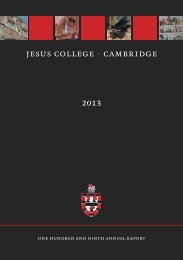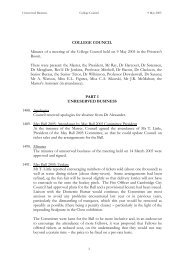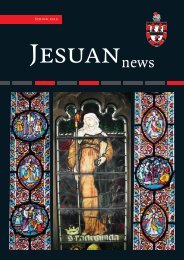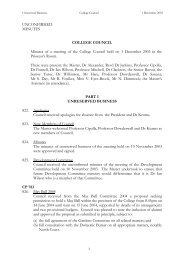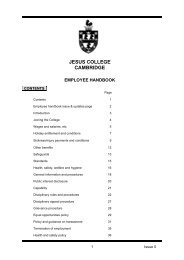2012 Annual Report - Jesus College - University of Cambridge
2012 Annual Report - Jesus College - University of Cambridge
2012 Annual Report - Jesus College - University of Cambridge
You also want an ePaper? Increase the reach of your titles
YUMPU automatically turns print PDFs into web optimized ePapers that Google loves.
CHAPEL COURT I <strong>Jesus</strong> <strong>College</strong> <strong>Annual</strong> <strong>Report</strong> <strong>2012</strong> 15<br />
so that the specific detail <strong>of</strong> the different buildings is respected. How the alterations <strong>of</strong><br />
the twenty-first century should “read” is therefore a major issue. When spaces are<br />
subdivided in new ways, how should the new insertions be expressed? One extreme<br />
would be to replicate the style <strong>of</strong> the two buildings concerned, but <strong>of</strong> course nineteenth<br />
and early twenty-first century college rooms did not have all the small bathrooms we<br />
now demand, so the proportions <strong>of</strong> the rooms were different, and rigidly “period”<br />
detailing would look curious. The other extreme would be to treat new insertions as<br />
entirely distinct: plastic “service pods”, for example. In common with most architects<br />
engaged in such work, BGS have aimed to steer a middle course: the insertions will be<br />
clear to anyone who seeks to discover these things, but unobtrusive enough not to<br />
announce themselves unnecessarily to the majority who do not. The staircases will be<br />
practically unaltered, so that superficially it will seem as if more than £11 million has had<br />
little noticeable effect.<br />
Less obvious still are the efforts the design team have gone to in order to minimise<br />
carbon emissions. Spurred on both by the City <strong>of</strong> <strong>Cambridge</strong>’s planning requirements<br />
and by the college itself, the services consultants, Hoare Lea, assessed the various<br />
options. Those areas <strong>of</strong> the south-facing ro<strong>of</strong> that are sufficiently shielded from view not<br />
to upset the Conservation Officer have had solar panels placed on them, which pre-heat<br />
hot water for showers. An alternative would have been photovoltaic cells and the cost<br />
benefits <strong>of</strong> the two systems are finely balanced; both feed-in tarrifs and manufacturing<br />
costs have changed since the choice was made but the solar-thermal solution is still<br />
reckoned to make a greater contribution to carbon reduction, with a 15-year pay-back<br />
period. In addition, ground-source heat pump technology has been employed. Its<br />
contribution to carbon saving is considerably more than solar-thermal installation, but<br />
the pay-back period is longer because <strong>of</strong> the capital cost <strong>of</strong> sinking 16 bore holes to a<br />
depth <strong>of</strong> 150 metres – about 20 years. GSHPs are most effective at producing low-grade<br />
Eric Gill’s sculpture over the Angel Gate





